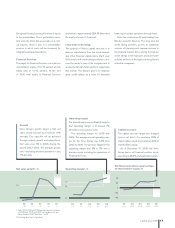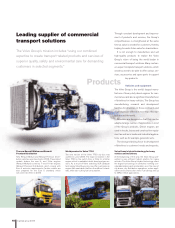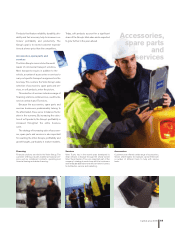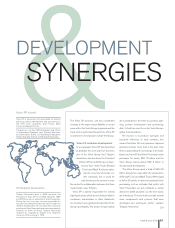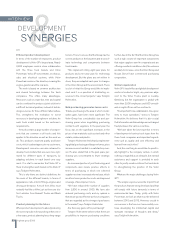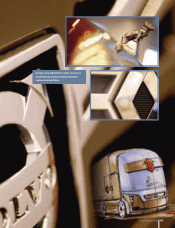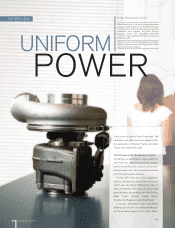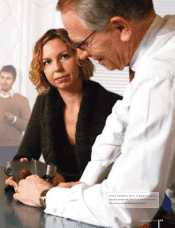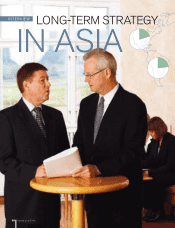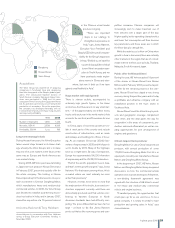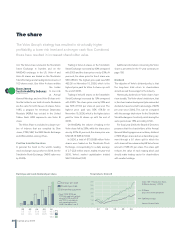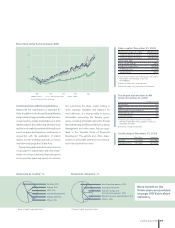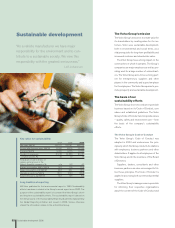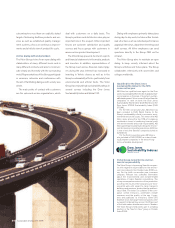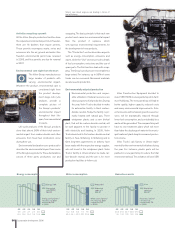Volvo 2006 Annual Report Download - page 30
Download and view the complete annual report
Please find page 30 of the 2006 Volvo annual report below. You can navigate through the pages in the report by either clicking on the pages listed below, or by using the keyword search tool below to find specific information within the annual report.
INTERVIEW UNIFORM
POWER
the world’s second largest company in its sec-
tor. Similarly, it was no small task to reorganize
the entire operation, while simultaneously
delivering annual volumes amounting to
200,000 engines and 80,000 gearboxes.
“We are t h e world’s l a rgest producer of heavy
diesel engines, from 9 liters up to 18 liters. Our
aim is to lead development in terms of perform-
ance, quality and environmental characteris-
tics, and to deliver our products at competitive
prices, ” explains Lars-Göran Moberg.
The driveline, which consists of the engine,
gearbox and the driveshaft or driveshafts, is
often described as the heart of a vehicle. Volvo
Powertrain is responsible for the development
and production of heavy engines, gearboxes
and driveshafts. The business unit is also
responsible for ensuring that the Volvo Group is
supplied with medium-heavy engines, which
come from partner company Deutz, in which
the Volvo Group holds 7 percent interest.
Powertrain is also a substantial manufac-
turer of heavy gearboxes in-house, with pro-
duction in Köping, Sweden and Hagerstown,
Maryland, in the US . Extensive efforts have a lso
been made in this area to standardize develop-
ment, purchasing and manufacturing, while
concurrently broadening the customer offer-
ing. Since its introduction in 2002, Volvo’s
internally produced AMT gearbox has grown
rapidly in volume at the cost of manual gear-
boxes. In practice, it is the industry standard in
Europe and was recently launched in North
America.
Common engine platforms
To date, increased volumes have been the driv-
ing force for profitability at Volvo Powertrain.
The decision to work toward two platforms is
aimed at further strengthening the business
area in the future, although the strategy gave
rise to costs during 2006 for both the new and
the old generation of engines, since both were
being produced in parallel for a while.
“We see considerable advantages in the
increased volumes and the concentration to
two platforms regarding costs for quality and
delivery precision,” says Lars-Göran Moberg.
The new platforms will further increase
economies of scale, since the Volvo Group
works with a common architecture and shared
technology. But Lars-Göran Moberg empha-
sizes that, despite this, the range of choices for
customers is larger than before.
The Volvo Group’s engine offering is one of
the broadest in the market, and engines are
adapted to the size of vehicles, what type of
transport work they will be doing, as well as the
environment in which the product is to operate.
“We develop and produce engines with differ-
ent characteristics, but based on common archi-
tecture and shared technology. The truck brands
will always retain their distinctive brand identity,
and the same applies to the engines. The most
important point for the customers is that we
produce drivelines that are optimized for the
transport work to be done by the specific ve -
hicle, combined with lower fuel consumption
and better operating characteristics. As a re sult
of the common engine strategy, Volvo Con-
struction Equipment and Volvo Penta also have
a solid competitive advantage with regards to
forthcoming emissions standards,” says Lars-
Göran Moberg.
Several advantages
The Volvo Group’s structure, with a common
business unit for the development, production
and purchase of drivelines, has several advan-
tages. Volvo Powertrain has concentrated its
expertise in research and development to spe-
cialized units in Sweden, France, the US and
Brazil. The division of labor is clear and there is
extensive cooperation between the units. The
joint focus on a platform creates synergies and
resources that help to improve the driveline’s
performance and cost-efficiency.
The production structure has also been
overhauled. Previously there were three differ-
ent industrial systems. Now there is a single
common system designed to achieve econ-
omies of scale, high quality and delivery reli-
ability, within which the four sister plants in
Göteborg, Lyon, Hagerstown and Curitiba sup-
ply their local markets with heavy engines and
heavy gearboxes.
Volvo Powertrain has also concentrated its
Lars-Göran Moberg
Lars-Göran Moberg, born 1943, holds a Masters
degree in Engineering and has been President of
Volvo Powertrain since 2001. He is also Board
Chairman of Volvo 3P and Volvo Technol ogy and
Technical Director of AB Volvo. He has worked for
Volvo since 1995 and has been a member of
Volvo’s Group Executive Committee since 2001.
purchasing – from nearly 700 suppliers a few
years ago to slightly more than 80 today. Those
that have been selected now have the capacity
to participate more actively in the development
process.
“It should also be borne in mind that we
implemented all these changes and develop-
ment projects at the same time as we were inte-
grating three formerly separate powertrain div-
isions,” says Lars-Göran Moberg. “Today, we
are a global organization with a coordinated
industrial structure, a common supplier struc-
ture a n d common platforms. Now we must make
sure that we get the maximum out of the new
product range and the new industrial system.”
Emissions requirements one
of the challenges
Lars-Göran Moberg identifies tougher emis-
sions legislation and changed customer re -
quirements as future challenges.
Lower fuel consumption is becoming in-
creasingly important both from an environmen-
tal viewpoint and from a commercial perspec-
tive, with fuel accounting for an increasingly
large proportion of operating costs. There are
several key steps along the way toward cleaner
engines f o r trucks and b u ses. The Euro 4 s t and-
ard was introduced in October 2006, and Euro 5
is planned for 2009. On January 1, 2007, the
US’07 standard came into force in the US. The
standard drastically reduces emissions levels
compared with only a year ago. A final step
towards ne ar zero emissions will be taken when
US’10 and Euro 6 will come into force in 2010
and 2012/2013 r espectively, according to plan.
26 A global group 2006



